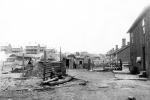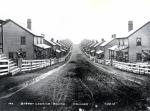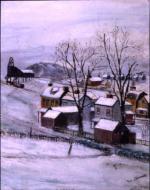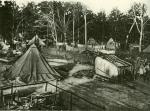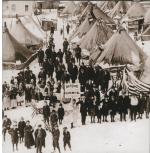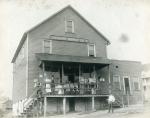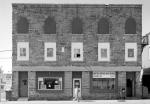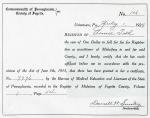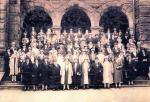Chapter 3: Life in the Coal Patches
"Straight rows of double houses placed close together, painted all a dull and ugly red, each house exactly like its neighbors, small back yards cluttered with sheds and privies, houses and yards showered with smoke and dust from the railway and the big mine tipple–the whole settlement one hideous ‘patch' on a fair, open hillside."
Ann Rochester, Labor and Coal, 1931.
Coal mining defined life above ground as much as it did below ground. Between 1880 and 1920, dozens of towns sprouted throughout the soft coal fields of central and western Pennsylvania to house tens of thousands of miners. Today, Pennsylvania's distinctive preponderance of independent municipalities–the Commonwealth is home to more municipalities than any other state in the nation–is a direct legacy of this period.
In the early 1900s Pennsylvania had more company towns, which were known as "coal patches," than any other state in the nation. A 1922 survey estimated that a little less than half of the state's estimated 180,000 bituminous coal workers lived in "independent communities." Most of Pennsylvania's bituminous coal miners–especially those living outside of large population centers–resided in company-built housing in company towns. In isolated, rural counties such as
Company towns were the result of geography and economics. Most of western Pennsylvania's bituminous coal deposits were located in what had been sparsely populated rural counties, so few of the existing towns were capable of absorbing the influx of new workers to the region. This was especially true in the late 1800s, when the lack of transportation networks made commuting from towns and cities to physically remote, isolated mining operations difficult if not impossible. Mining "camps" had to be built to both attract and retain a labor force. As one federal investigation concluded in 1917, "A housed labor supply is a controlled labor supply."
Company towns had common features. They were built and owned by one company and were highly stratified. Larger, better constructed houses were reserved for owners, bosses and foremen, while immigrants and unskilled workers occupied cheaper housing units. In the interest of efficiency, there was little variation within housing stock. The most common house type was a semi-detached, two-story, wood-frame double house. (Row houses were cheaper to build, but they could also catch fire more easily.) Town plans were often similar. Mining companies arranged houses in linear fashion along a main road. Bosses' houses typically stood adjacent to mining entrances, so that foremen could be close by in the event of accidents or work stoppages. The company store, on which miners relied for everything from foodstuffs to mining supplies, typically stood in the center of town.
Although the proportion of foreign-born residents varied over time, most company towns at the turn of the century were dominated by recently arrived immigrants from southern and eastern Europe. In many company towns, the share of foreign-born ran as high as 75 percent. In larger mining towns, immigrants self sorted by nationality in distinct neighborhoods, as revealed by such informal place names as Pole Town, Swede Street, and Hunky Hollow. Women did not work in the mines, but the wives of immigrant miners played a critical role in the household economy. Many took in boarders to supplement incomes, and managed a range of duties, from purchasing food and preparing meals to minding the children and drawing the evening bath.
Another feature common to company towns was corporate control. Thanks to company-built housing and the ubiquitous company store, miners rented their homes and purchased goods, often using company-issued "scrip," from the company that employed them. In comparison to the private rental market, company houses were cheaper and often included free or heavily subsidized utilities such as electricity, heat, and water.
Company stores, sometimes referred to as "grab alls," also allowed workers to buy goods on credit. But such advantages came with strings. Prices at company stores were typically higher than at other establishments. Rented company housing kept workers and their families in a permanent state of vassalage. The constant threat of eviction discouraged miners from challenging company authority and joining unions, as did the prospect of withheld credit at the company store. In larger company towns, such as
Labor disputes laid bare the intricate web of corporate control. During the
The havoc caused by the 1922 coal strike compelled President Harding to convene a special commission to investigate conditions throughout the nation's coal-mining regions. A second, independent commission concluded in no uncertain terms that bituminous firms in southwestern Pennsylvania treated mineworkers worse than slaves. Such widely publicized reports rarely resulted in improvements, but some mine operators did make efforts to improve living conditions, if only to avoid negative publicity and retain skilled workers. The Washington Coal and Coke Company achieved something of a success with Star Junction, a model town in Fayette County, but the Berwind-White Coal Mining Company's effort to project Windber as a model town failed.
The most substantial reforms were initiated by outside organizations such as the American Friends Service Committee (AFSC), a Quaker social-service organization based in Philadelphia. During the 1922 strike, the Friends sent volunteers into the coal patches to feed and clothe the families of striking miners. They also tried to redress persistent economic inequality.
Inspired, in part, by the Friends example, the federal government during the 1930s launched an experimental housing program aimed chiefly at relocating "stranded miners" from isolated, rundown mine patches onto farms, as part of a "back-to-the-land" movement. Unemployed miners moved into new, sturdily built homes with running water, and tended land on which they could raise food, both individually and cooperatively with other residents. One of the first of these communities, the Westmoreland Homesteads project, was outside of Greensburg. (It was later renamed
As coal production sagged in the decades after World War II, so, too, did the number and size of the region's once dense coal patches. "What are the people in the crowded patches going to do when there are not jobs for the union leaders to regulate?" investigator Muriel Sheppard wondered aloud in 1946. "The day is close and we have already had a taste of what it will be like when the coal is gone." When the day did come, operators either leveled the old company housing to avoid property taxes, or sold off occupied homes to private individuals or third-party realtors. Patches that were situated close enough to alternative sources of employment managed to survive as residential communities.








